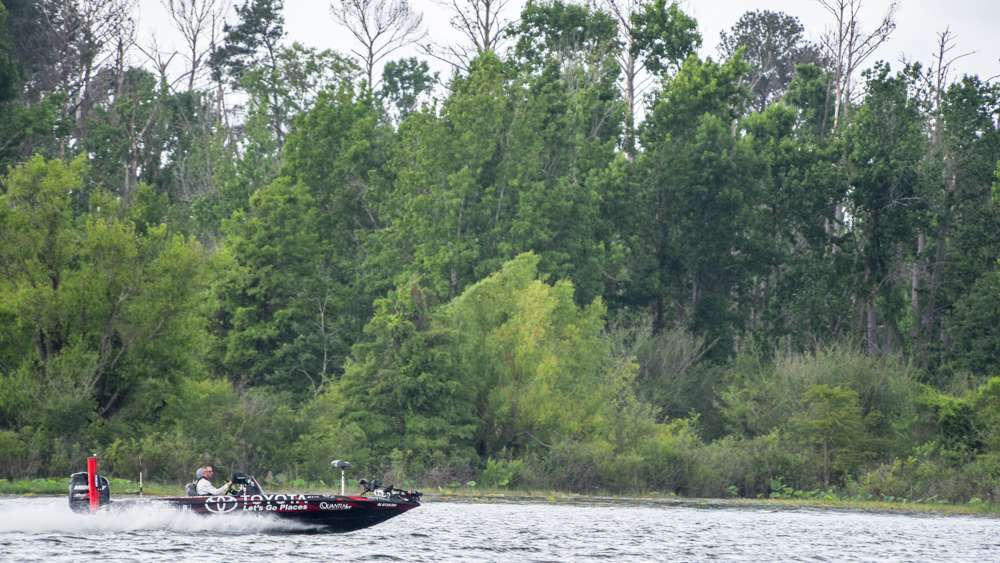
LUFKIN, Texas — All week the pros have spoken how good the bass fishing is at Sam Rayburn, site of Toyota Bassmaster Texas Fest. So how good is it?
“This is the best bass lake in the country right now,” said Kevin VanDam, undeniably one of the best bass fishermen of all time.
After three days, and on any given day, the pros reported catching 50 or more largemouth. Hank Cherry said he went through 70 bass one day. Going through the numbers, he said, was necessary to get the bigger bites. Brent Ehrler caught a bass weighing 9 pounds, 1 ounce on Day 1.
Why is the fishing so good?
There are three parts to that answer. Sound fisheries and resource management, abundant habitat, and good weather for growing bass are those reasons.
“If you have to point to one factor why the fishing is so good then it’s the ideal habitat conditions,” said Todd Driscoll, district fisheries biologist for the Texas Parks and Wildlife Department.
Ideal habitat is defined as the consistent and ongoing cycle of vegetation growth. At Sam Rayburn that ideal scenario is ongoing in both shallow and deep zones preferred by largemouth. What is more, when habitat flourishes like it does on Sam Rayburn that leads to high survival rates by fingerling-sized bass.
Lakes typically go through cycles in terms of fishing success. Environmental changes like drought and seasonally high wet conditions are the reasons why. That hasn’t happened at Sam Rayburn.
“If you look back to 2000 we’ve had only two relatively poor years, or drought periods, for growing bass,” said Driscoll. “When you have consistently good habitat growth year over then it leads to strong year classes of bass.”
If you could build a dream lake, including managing of the uncontrollable environmental variables to make it perfect, you have that dream turned into reality at Sam Rayburn.
Consider these dynamics.
On average, water level fluctuates 6 to 8 feet each year. High water during winter and spring inundates terrestrial vegetation during the bass spawn, which results in high survival of hatched bass. What fishermen call “hay grass” is scientifically called torpedo grass. Add buttonbush and willows, two predominate types of shoreline cover, and the perfect nursery exists for rearing baby bass and their spawning parents.
As lake levels drop during summer and fall the shoreline dries and becomes more conducive for plant growth. More willows sprout and so does the torpedo grass and buttonbush.
Meanwhile, summer is an ideal growth period for hydrilla, which is abundant on Sam Rayburn. The bass move deep into the hydrilla beds where the water is cooler. Baitfish follow and the bass use that hyrdilla for ambushing their favorite food. They get fatter.
And there you have it, the perfect setup on 114,500 acres of powerhouse east Texas bass fishery.
That ideal habitat growing cycle over the past 17 years leads to perfect conditions for bass populations to increase. One generation builds on the over. High survival rates lead to more and bigger bass.
Driscoll also noted the high habitat growth is aided by the resource management practices of the U.S. Army Corps of Engineers and Lower Neches Valley Authority.
“They maintain a water level guideline curve, and that curve is ideal for fish production,” he explained.
Driscoll pointed to another contributing factor. TPWD has stocked Florida largemouth in the lake since 1975. To be exact, over 19 million have been stocked in the lake. In recent years annual stockings were between 500,000 and 700,000 Florida largemouth fingerlings. The idea, of course, is to increase the potential of catching trophy bass.
That has worked well over the years. Sam Rayburn has contributed 26 entries to the Toyota ShareLunker program. The lake ranks third behind Lake Fork (257) and Alan Henry (27) for the most bass weighing 13 pounds or more entered into the program for a given fishery.
Coincidentally, and this puts a lot into perspective, Toledo Bend comes in with only 7 entries.

